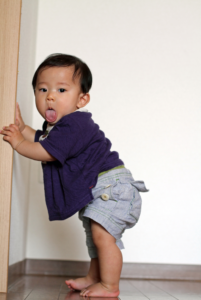November 20, 2022
In this week’s article, we examine the First Year of Life and how it lays the foundation for Social Ability. It is the first article in a series that will focus on the development of social ability throughout early childhood.

The first year flies by so quickly as we are immersed in the busyness of supporting the new tiny, vulnerable wonder in our life. Yet as quickly as it passes, it is full of crucial foundational milestones and growth. Imagine all that occurs in that first twelve months:
A cosmic being makes the journey to earth, where they are met with a fully physical world of matter and gravity. Our baby enters life as a bundle of chaos, needing our support to come into the natural rhythms of breathing, eating, sleeping, waking, and so forth.
We work tirelessly to establish rhythms and routines for them and ourselves as we also treasure these fleeting first months. We schedule feedings, add nurturing rituals to bedtimes and nap times, stimulate and bring activity by day, hoping that they will quickly fall in with the circadian rhythms of the earth. And gradually they do, moving from sleeping just as much as our cats to fighting that afternoon nap in the light of dawning consciousness of the world around them.
Very gradually, they move from frantic jerks in their limbs to control; often first moving the eyes and head with intent, then the hand to meet what their gaze has landed upon. With the help of early movement patterns (also known as primitive reflexes) our infant naturally overcomes these automatic movements, replacing them with ones full of intention, defying gravity and culminating in uprightness.
Meanwhile, the tonal aspects and cadence of murmurs heard in the womb come to match the voices of their loving family. Warmth is recognized through tone and pitch, singing especially acts as a soothing and protective embrace. Before too long, these sounds become recognized as having meaning. Mama, Dada, bubba, sis, ball, dog, eat… all of these simple images and concepts begin to take shape with the words assigned to them, and even take shape in a little ones mouth with the first syllables being mumbled. All of this language, as it surrounds them and begins to be used by them, helps to strengthen the structure and form to their growing bodies.
 Through it all, their interest in the surrounding environment and the people in it grows, giving us the message that they are finding a home here on earth. Their smiles become real, they laugh and cry to communicate, the reach for us to pick them up, they pull pet tails, knock down sibling block towers, feed themselves, and generally explore with enthusiasm this extraordinary new life. They transform from a helpless, disorganized newborn into a toddler already living with intent and purpose.
Through it all, their interest in the surrounding environment and the people in it grows, giving us the message that they are finding a home here on earth. Their smiles become real, they laugh and cry to communicate, the reach for us to pick them up, they pull pet tails, knock down sibling block towers, feed themselves, and generally explore with enthusiasm this extraordinary new life. They transform from a helpless, disorganized newborn into a toddler already living with intent and purpose.
As parents we have the task of recognizing what is contained in this first year of life so that we may take care in all that we do with and for them. We are setting the stage for a strong sense of security and safety, and of belonging in the world. We are protecting their freedom to move, to interact, to come to know themselves and us as separate beings, each with our own destinies to fulfill. They are ours to protect and love, ours to model goodness, beauty and truth for, but they are not ours to keep. The beautiful, bittersweet crux of parenthood is that the moment we welcome them into this world, we are also setting them free, bit by bit.
As caregivers and educators, we too must hold this knowledge and understand that it is our honorable task to secure the continuity of a free individual journey for each child that comes into our care. We strive to learn how best to support and guide them as partners with each of their families.
Warmly,

This is absolutely beautiful, inspiring and truth-filled, Acacia. Thank you so much!